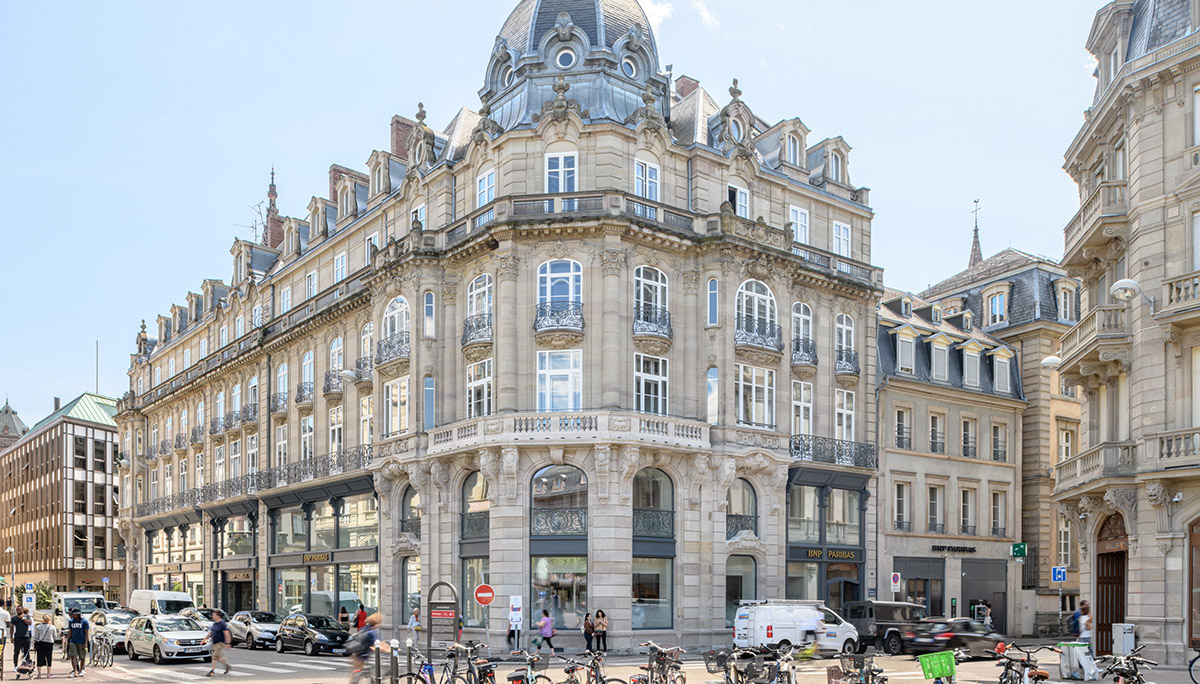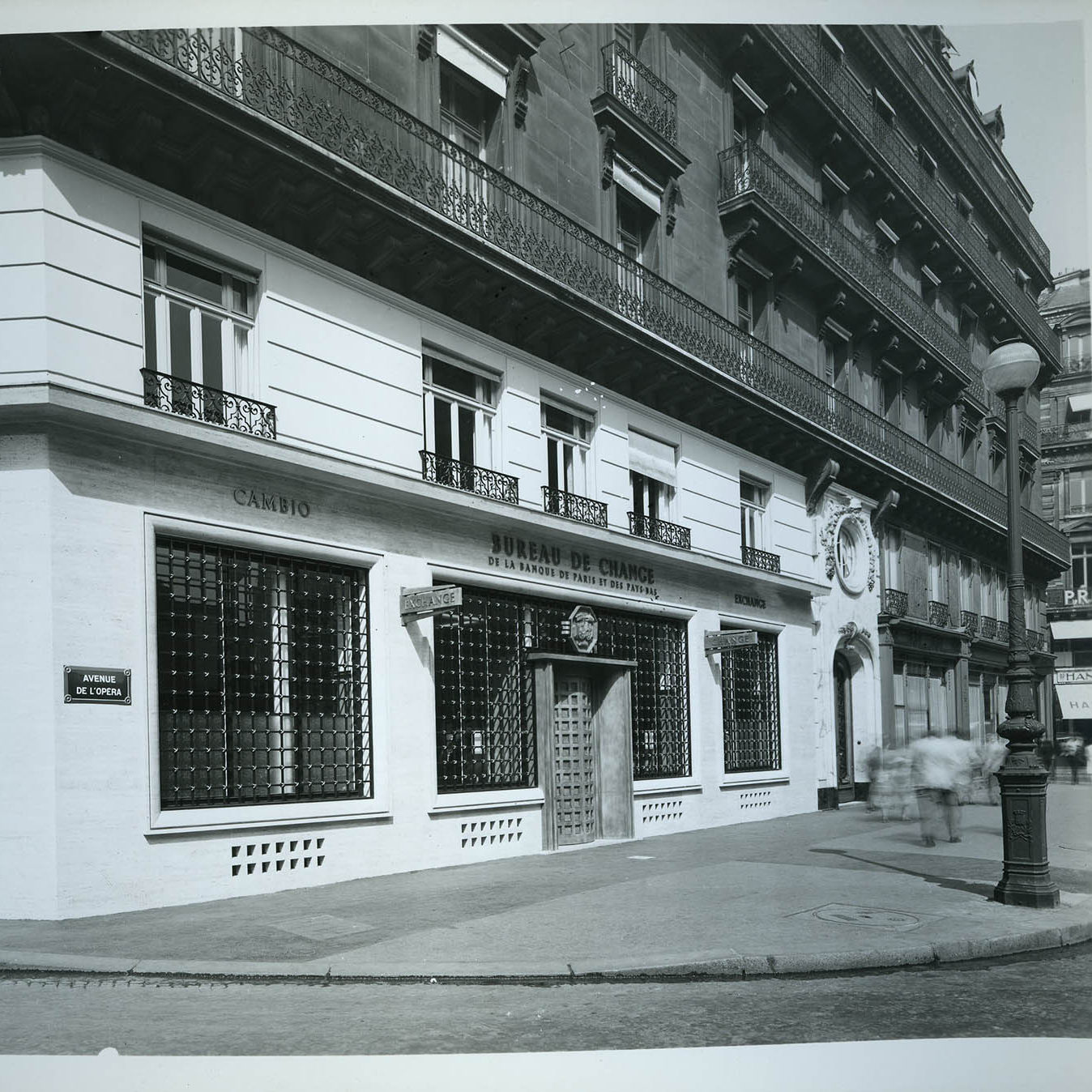Strasbourg-Dôme : an iconic agency for Alsace history and bank architecture

For more than 100 years, BNP Paribas and its ancestor banks have been involved in the economic life of the Strasbourg region. In fact three of our ancestor banks followed each other on rue du Dôme. Reflecting the upheavals and rebirth of France and Strasbourg, the bank and its architecture also reflect this. This is how the renovation completed in 2023 by BNP Paribas is rehabilitating the Haussmann architectural style, which symbolizes its creation.
When Comptoir d’escompte de Mulhouse leaves its place in the Banque nationale de crédit twice

Owned by the Protestant Church of the Temple Neuf, the No. 2 building on the rue du Dôme went through three wars in less than a century. Although the Prussian bombings of 1870 did not destroy it, the damages still required substantial work. The Dresdner Bank, a German bank, set up its commercial operations there, since Strasbourg was once again attached to Germany.
Between 1899 and 1902, Charles-Émile Salomon, architect of the Protestant Church of the Temple Neuf, set out to improve the building and draw a facade in the Haussman style. The domed rotunda with the skylight at the corner of the Dome and Students Streets becomes emblematic of the Place Broglie.
The Comptoir d’escompte de Mulhouse (CEM) is already present in the Alsace region. By 1913, however, it had been replaced by the newly created Banque nationale de crédit (BNC). The CEM transfers almost all of its business to the BNC.
Two countries, three names: the Strasbourg-Dome agency lives at the pace of its border
At the end of the First World War, France recovers Strasbourg and, as early as April 1919, the BNC, as part of its extension policy, opens a branch there (it will open a second in Metz soon after). The latter therefore signs a three-year renewable lease with the Consistory of the Protestant Church of the Temple Neuf, which still owns the building.
As a symbol of a war-torn business environment, the CEM’s activities quickly resumed. Including in the areas recovered, even if the present climate is special. Indeed, the Franco-German border is once again being redrawn, but the governance changeovers between the two countries leave many traces. For example, everything has to be checked since counterfeit German banknotes printed in 1919 are in circulation. This was requested by the BNC management from all its agencies in its 1921 letter opposite.
On the other hand, until 1938 the bank housed an office dedicated to the Dresdner bank teams so that they could liquidate the accounts of their former customers in what is now French territory.

In 1922, the CEM regained its registered office in Strasbourg on Le Dôme Street before finally leaving it in May 1930 when it was dissolved for the BNC. The trade name listed on the forehead of the foreign exchange rotunda changed again to display that of the Banque nationale de crédit.
Arrival of BNCI : the third ancestor bank of BNP Paribas takes the stage
In 1932, the Banque nationale pour le commerce et l’industrie (BNCI) absorbed the BNC and thus its Strasbourg branch. In 1940, the Germans forced BNCI to free the place again for Dresdner Bank until November 1944. At the Liberation, the BNCI, which has been involved in the economic life of the region for many years, resumed its Strasbourg headquarters and its expansion policy.

Between the wars, the branches of Selestat and Haguenau were created, followed by the branches of Bischwiller, Barr, Schirmeck and Pfaffenhoffen. From 1952, a new office will be set up at the port of Strasbourg together with six new agencies: Mutzig, Reischoffen, Rosheim, Seltz, Soufflenheim and Soultz-sous-Forêts.
By rapidly developing its network of banking agencies, BNCI shows that it has inherited the energy of its ancestral banks. This is true even though the human and financial repercussions of successive conflicts are significant. It should be noted, for example, in this particular post-war context, that the Consistory, still the owner of the premises, is reassessing the rental of its property, as authorised by the 1945 decree of the Commissioner of the Republic. The rent on Du Dome Street is then increased by 50%. A lesser evil when we know that, initially, the owner asked for an annual rent multiplied by four!
Architecture as a reflection of the evolution of the bank’s image
In 1958, Strasbourg endured a severe storm in July and then a hurricane in August. The branch manager’s residence is damaged and quick action is required to make it liveable. The director urgently finds roofers and 8,000 tiles to restore the roof of his home. But the owner refuses to take over the work! This led to a dispute that lasted until 1960.
BNCI plans to carry out repairs in 1958. Two world wars and societal change had made it compulsory to adapt the agencies to the emerging new lifestyle.

In May 1960, the bank obtained the agreement of the Consistory to carry out the work. With the climate events of 1958, the rain had dropped behind the facade linings. It is a double opportunity to review the building’s architecture. The mode is on clean lines and in an open interior space. The facade is then covered with a facing all along the first floor, removing the original cut stones and sculptures.
A surprising situation appears then: the Klein grocery store is adjoining the agency. The BNCI has occupied two of its cellars since 23 November 1944 and provided heating for the grocery store. To “maintain good neighbourly relations”, BNCI decides to take over the 220,000 francs for heating renovation (currently EUR 429,000).

Rehabilitation to revive the original facade
In addition to the ongoing rehabilitation and modernisation of the agency, it was not until 2010 that a new major rehabilitation and restoration project began.
After preliminary studies and consultation with local stakeholders, a huge rehabilitation project was carried out between 2021 and 2023. The association between BNP Paribas, the Saab architecture workshop and the construction group Demathieu Bard marks a new architectural turning point: the renovation of the facades enhances the sculptures and the cut stone by restoring their original lustre as it was before the works of the years 1958–60.
A heritage stone sculptor intervenes to recreate the four lions’ heads from archival images. Interior design, on the other hand, follows current standards and regulations on safety and accessibility. The premises now accommodate 140 employees, including the Grand-Est regional management.
Agency after rehabilitation and restoration work

Partager cette page










